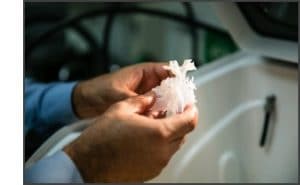Innovations in Medical 3D Printing: What You Need to Know
 The goal for those in the medical field is to improve patient outcomes, but how they get there is much more complicated. Doctors, researchers, and manufacturers are constantly evolving their work to keep pace with new technology and developments that can keep people healthier for longer.
The goal for those in the medical field is to improve patient outcomes, but how they get there is much more complicated. Doctors, researchers, and manufacturers are constantly evolving their work to keep pace with new technology and developments that can keep people healthier for longer.
Medical 3D printing is one of many 3D printing innovations that has broken onto the scene and is changing the way those in the medical field approach their jobs. Whether it’s 3D printing a new prosthetic or making medical models more efficiently, medical 3D printing is changing the game for the medical field. Because the impact of technology is far-reaching, manufacturers, doctors, and researchers should all be aware of the applications of medical 3D printing so far, and where it can be headed in the future.
Medical Models
One particular area of interest for doctors is medical 3D printing’s ability to create patient-specific models. While scanning technology such as an MRI can allow doctors to see the intricate details of a patient’s anatomy, the images are only a one-dimensional representation. By marrying the results from scanning technology and 3D printing technology, doctors can print a complex model of that specific patient’s anatomy and use it to troubleshoot.
This is particularly useful when a patient requires an unusual or high-risk surgery. The 3D model gives surgeons the opportunity to plan a course of action and rehearse; Dr. Redmond Burke of Nicklaus Children’s Hospital in Miami, for example, used medical 3D printing to create a realistic and flexible model of a young patient’s heart. Burke explored possible repairs on the model, and was eventually able to find a solution he could walk through with his team and the patient’s parents.
 Another high risk surgery at Boston Children’s Hospital was performed this year using 3D printed medical models which allowed the surgeon to practice their maneuvers before the actual surgery – this resulted in saving approximately 6 hours of surgical time with Bentley therefore reducing all kinds of medical complications – watch video.
Another high risk surgery at Boston Children’s Hospital was performed this year using 3D printed medical models which allowed the surgeon to practice their maneuvers before the actual surgery – this resulted in saving approximately 6 hours of surgical time with Bentley therefore reducing all kinds of medical complications – watch video.
The ability to experiment with realistic models is finding similar use in training, where medical students can “operate” on replicas in a no-risk environment. While surgical training once relied on textbooks, hands-off apprenticeships, and 2D scans, 3D printed medical models give students an opportunity to properly explore human anatomy. Similar to Dr. Burke’s 3D printed heart, educational models can be printed in different anatomies so students can work through a variety of scenarios and potential problems. Some 3D printers have become so advanced they can print multiple colors and textures that replicate bone and tissue in intricate detail; one PhD student was able to 3D print a model of a baby’s rib cage and internal organs, which he hopes will help medical professionals improve the success of their procedures.
Prototype Parts
Manufacturers of medical devices are well aware of rapid prototyping, which allows them to quickly move conceptual ideas to trial-ready products. 3D printing is particularly useful in this area, because traditional manufacturing methods can be more expensive and significantly slower; while traditional manufacturing typically requires multiple pieces to be assembled by a third-party, 3D printers can print an entire piece on-premise. The quick turnaround for products means manufacturers and even hospitals can move through designs and prototypes at a faster speed, allowing them to help patients sooner. It is also beneficial to manufacturers, since creating better products, faster, is in their best interest from a revenue standpoint.
Medical Devices
3D printing is not limited to just prototyping; manufacturers can 3D print the end part, as well. The Federal Drug Administration (FDA) recognizes the applications of 3D printing in the medical field, and regulates 3D printed medical devices “through the same pathways as traditional medical devices,” which means “they are evaluated according to the safety and effectiveness information submitted to us by the manufacturer.” Although some traditional manufacturers may be skeptical of 3D printing’s capabilities, there are numerous examples of 3D printed medical devices being cleared by the FDA. Some examples include:
3D Printed Prosthetics
The use of 3D printing to create prosthetics is perhaps one of its most well-known examples in the medical field; in fact, there’s an entire organization dedicated to printing free hands and arms for those who need them. 3D prosthetics are significantly cheaper than their traditionally made counterparts, which is especially important to young children who will outgrow their prosthetics. One man who received a 3D printed hand from Ottawa Hospital said it only cost him $200, in comparison to his previous $3200 traditionally-manufactured model.
3D Printed Parts
3D printing has also made headway in medical parts, which can accelerate the development time of a larger medical device. A company specializing in ophthalmological diagnostic systems was able to use 3D printed parts in their Gonioscope, which prevented delays and got them to clinical trials (which they passed) faster.
The Future of Medical 3D Printing
Although medical 3D printing has already disrupted the industry in many ways, the innovation is far from over. Many scientists are continuing to experiment with 3D printing’s capabilities to make solutions that save more lives. Whether you’re just becoming aware of medical 3D printing or already immersed in it, manufacturers, doctors, and researchers should keep a close eye on its life-saving possibilities.
Learn More
Want to learn more about 3D Printing? Visit our product page.
Related Articles
The Future of Manufacturing: 3D Printing Innovations
Metal 3D Printing Solutions: The Desktop Metal and Fisher Unitech Partnership
Agilus 30 – 3D Printing Rubber – Everything You Need to Know
About the Author
 Lisa Hannon is a marketing manager at Fisher Unitech. She develops content for 3D printing topics that have an impact across all industries that are researching ways to maximize getting products to market faster as well as cost savings with 3D printing solutions. Lisa has worked as a marketing management professional since 1998, most recently with Stratasys.
Lisa Hannon is a marketing manager at Fisher Unitech. She develops content for 3D printing topics that have an impact across all industries that are researching ways to maximize getting products to market faster as well as cost savings with 3D printing solutions. Lisa has worked as a marketing management professional since 1998, most recently with Stratasys.

 Blog
Blog